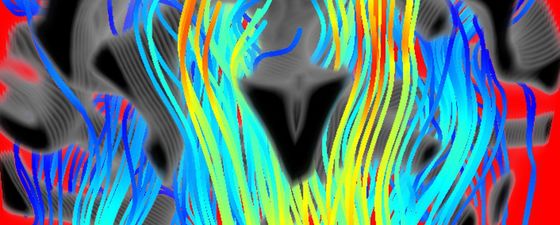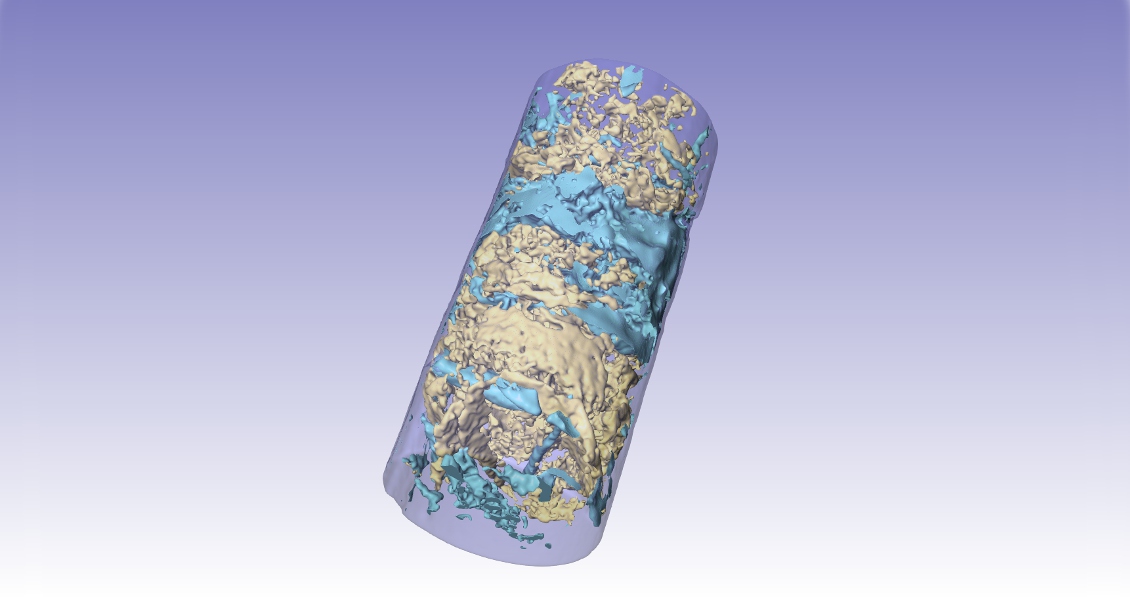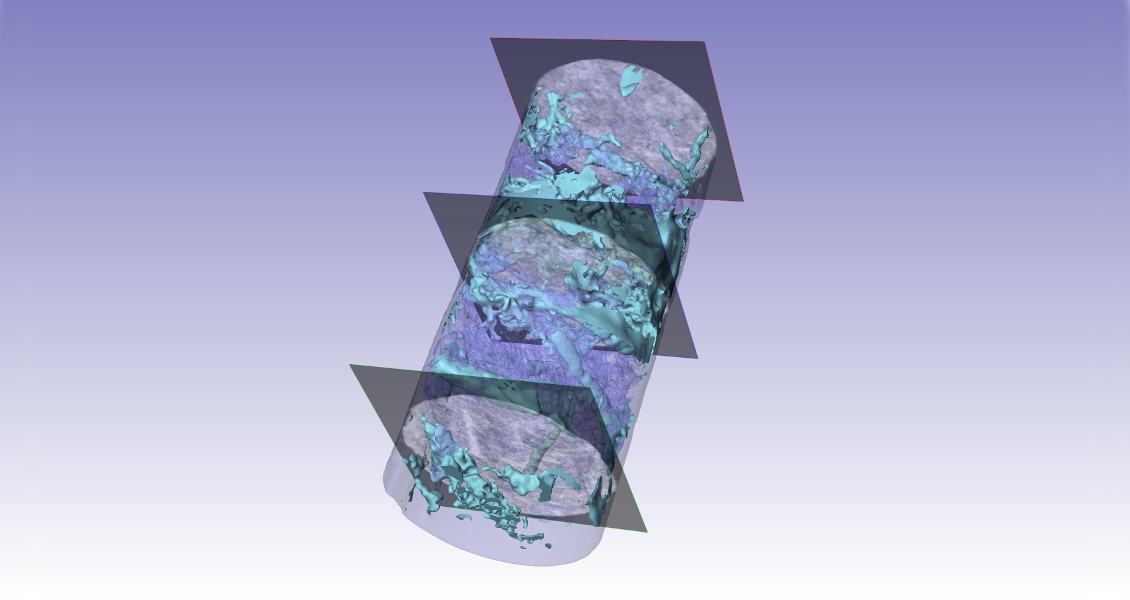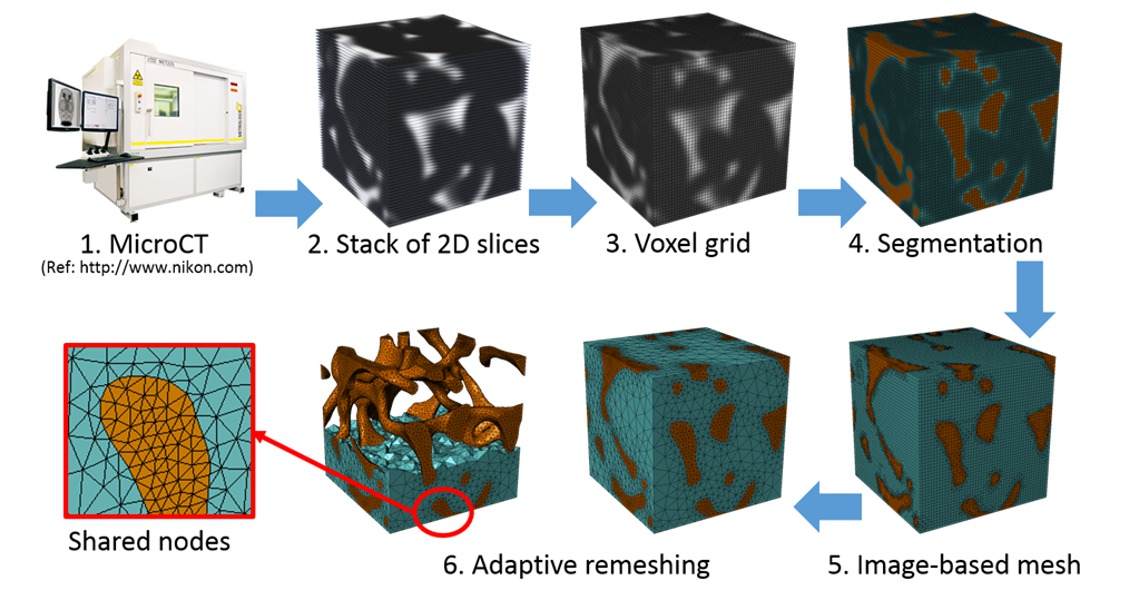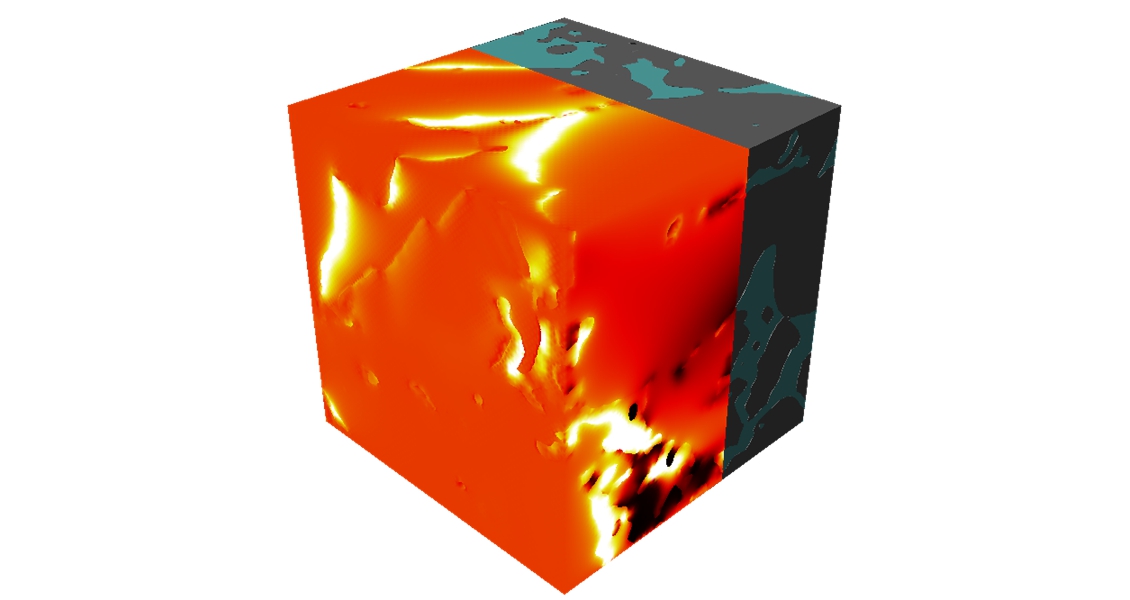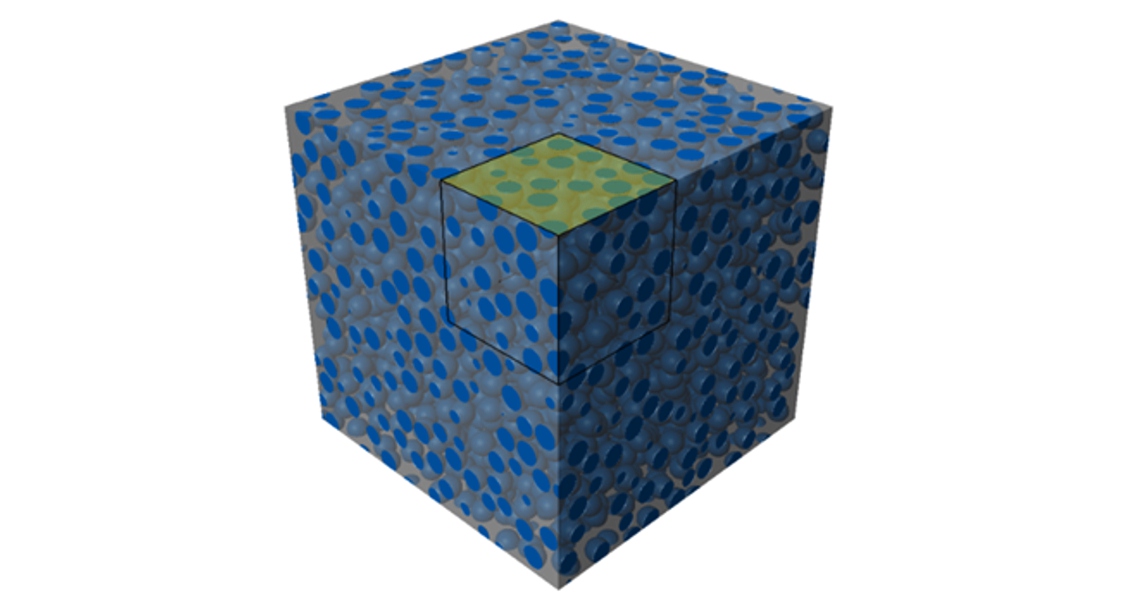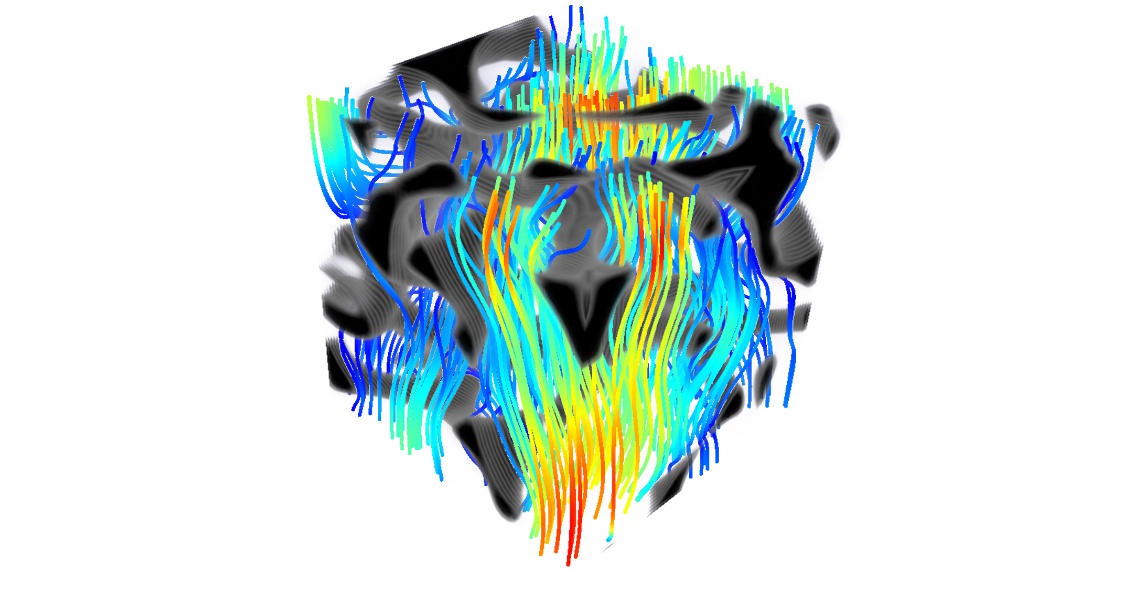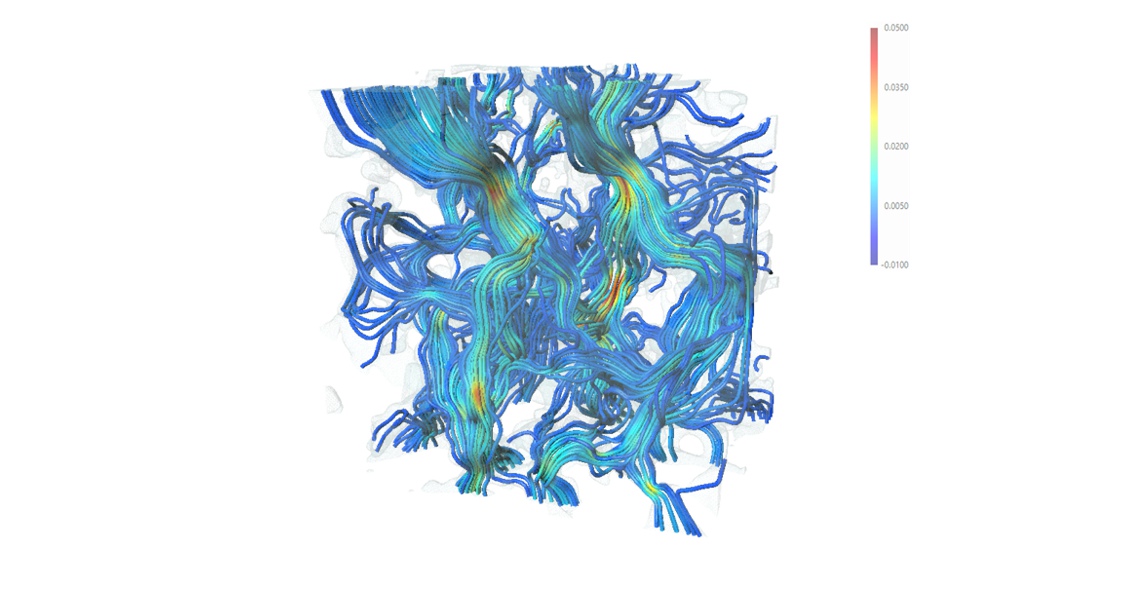Oil and gas researchers have a range of options available to them when analyzing rock samples, from more traditional experimental methods to techniques that use computational simulation. Virtual special core analysis and digital rock physics allow specific features of cores and geological samples to be analyzed from 3D scans, including porosity and transport properties. This type of analysis has the potential to cut down on laboratory waiting times in areas such as reservoir characterization, hydrocarbon production, and many others. However, getting to grips with software solutions for digital rock physics can be difficult for non-experts, creating the need for integrated techniques.
From Scan to Simulation
 Simpleware core sample visualization.Digital rock physics involves obtaining high-resolution image data of rock samples, which provides an alternative basis for exploring rock properties compared to laboratory tests or theoretical models that approximate an actual geometry. While these methods are valuable, being able to scan and obtain 3D models of the complex microstructure of a rock sample can provide a deeper understanding of pore geometries and other features such as elastic and electrical properties.
Simpleware core sample visualization.Digital rock physics involves obtaining high-resolution image data of rock samples, which provides an alternative basis for exploring rock properties compared to laboratory tests or theoretical models that approximate an actual geometry. While these methods are valuable, being able to scan and obtain 3D models of the complex microstructure of a rock sample can provide a deeper understanding of pore geometries and other features such as elastic and electrical properties.
3D images of rock samples can be obtained by using scanner types like computed tomography (CT), microcomputed tomography (micro-CT), and FIB-SEM (Focused Ion Beam-Scanning Electron Microscopy). These volume imaging techniques produce data that can be explored using image processing and simulation software to understand material phases, grain structure and porous networks without having to carry out destructive tests.
In a standard digital rock physics workflow, a sample object is scanned, with micro-CT typically producing the highestquality images. Scanners reconstruct image projections to create a stack of images that can be exported in different formats, such as BMP, TIF, or PNG, which then somehow need to be transformed so that the properties of the core can be modeled and analyzed. Simpleware Ltd, a UK-based company, has developed software solutions that make it fast and easy to convert rock sample scans into simulation-ready models.
Image-based Meshing
A stack of images is imported into the software, and each image slice extruded to convert 2D pixels into 3D pixels, or voxels. To identify different materials phases, it is possible to distinguish between brighter voxels which have a higher density representing solid domains, and darker voxels representing surrounding air or fluid. Image segmentation techniques are used to label voxels that belong to specific regions of interest, such as different materials, and are supported by image processing tools. At this stage in a digital rock physics workflow, image noise created during scanning can be removed to enhance image contrast, while segmentation techniques such as thresholding can identify pores. Other software tools can remove unwanted features and segment particles, while initial measurements and statistics can be obtained on surfaces, volume areas and porosity.
Once image segmentation and processing is complete, models can be exported as a mesh, or grid, for numerical simulation. Finite element and computational fluid dynamics simulation approaches work here to predict the response of the sample to physical stimuli, for example an applied pressure gradient, generating valuable data. However, researchers and analysts who work with these types of data often have to carry out more work on meshes in simulation software before they can be used.
Simpleware’s solution, by comparison, creates numerical models that can be directly exported and used in these simulation packages, and uses a novel image-based meshing method to maintain the original geometry of a scan. This involves taking the original scan data’s voxel-grid and converting the voxels into mesh elements that accurately represent the original scan; this approach is distinct in the field of digital rock physics for being able to handle multiple material parts, where the accuracy of a model only depends on the quality of the original image and how the user chooses to segment regions of interest.
Understanding Material Behavior
The company has also developed software modules (the Physics Modules) for calculating effective material properties of scanned rock samples; individual modules can be used to retrieve properties such as the stiffness tensor, porosity, absolute permeability, electrical conductivity, among others. Homogenization, the method underpinning the calculations, is based on the idea that a complex heterogeneous material can be approximated by a homogeneous material with effective physical properties chosen so that it responds to different inputs in a manner very similar to the original material. Replacement of a microstructured medium by a uniform material vastly simplifies its analysis and reduces the computational resources required for the study of its behavior in macroscopic settings – for example, when the scanned rock is analyzed as part of a large reservoir. This approach can be useful, for example, when analyzing scans of different rock types obtained during reservoir characterization.
Built-in finite element analysis capabilities can be used to calculate the fields induced in a sample subjected to a series of stimuli, represented mathematically with specific physics-dependent boundary conditions. For example, when the absolute permeability of a porous material is sought, the fluid velocity fields generated by pressure differences applied between the three pairs of opposite faces of a cubic sample of that material would be calculated. By post-processing these fields, the algorithm obtains the values of the effective physical properties of the sample. The software is designed to make it easier to quickly run simulations and get results. The use of image-based meshing and decimation of surfaces is particularly useful here as the size of meshes can be reduced without compromising their fidelity to the original geometry derived from the image.
The Simpleware Physics Modules contain tools that can be used by non-specialists working in oil and gas exploration to interpret results; these include convergence graphs that indicate whether the obtained results are accurate, and in particular whether the sample size is large enough to provide meaningful results. The software is able to calculate full tensorial effective properties as well as their best approximations matching specific assumptions about the material symmetry, for example isotropy, where the properties of the sample are identical in all directions. The fields induced by each set of boundary conditions used in the homogenization process can also be visualized or animated within the software suite.
Intuitive Software Needed
Making these results easy to obtain, and ensuring that safeguards like convergence graphs and other tools for deciding on the quality of generated meshes and results are available, is a key goal for digital rock physics software. In the same way, the use of scripting to automate or partautomate typical workflows has the potential to cut down on time-consuming tasks in the laboratory when working with multiple datasets.
The effectiveness of these software approaches has been tested by Simpleware using digital rock physics data from ETH Zurich, as well as data from published literature. For example, micro-CT data of a dry Berea sandstone sample was segmented in order to identify quartz and mineral inclusions and air occupying pores. Different meshes were tested, and effective properties calculated for elastostatics, viscous fluid flow and electrical conductivity. The results showed good agreement with published techniques and experimental data.
Future applications for digital rock physics involve adapting to changing computational resources, as well as working with samples where pores are filled with substances like clay or oil. Being able to accurately represent these fine features has significant potential for increasing the effectiveness of digital rock physics.
To make simulation technologies more accessible to geologists, technical software needs to become more intuitive and offer a simple and flexible workflow to handle complex tasks. The software solutions provided by Simpleware are focused on reducing the learning curve associated with digital rock physics and integrating multiple tools into the same interface. Continuing to add detail and customization options to analysis of porosity and permeability is another goal for the technology, particularly when studying unconventional reservoirs and tight rocks encountered during fracking operations and other forms of exploration.

